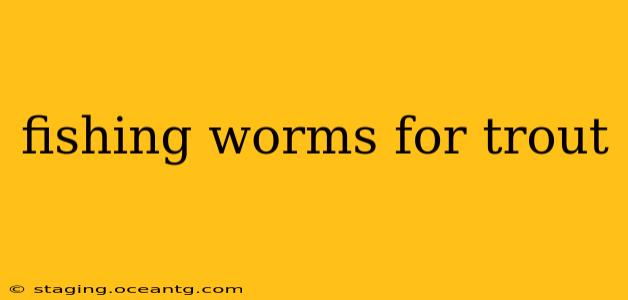Trout, prized for their fighting spirit and delicious flesh, are a favorite target for anglers worldwide. While many anglers focus on lures and flies, the humble earthworm can be a surprisingly effective bait for trout, especially under specific conditions. This guide explores the best types of worms for trout fishing, effective techniques, and frequently asked questions to help you land your next trophy.
What are the Best Types of Worms for Trout?
The effectiveness of a worm depends largely on the size and species of trout you're targeting, as well as the time of year and water conditions. Generally, smaller worms are best for smaller trout, while larger worms can attract larger fish. Here are some top contenders:
- Nightcrawlers: These large, juicy worms are a classic choice, particularly effective for larger trout. Their size makes them highly visible and appealing. However, they're often too large for smaller trout and can be challenging to keep alive.
- Red Wigglers (Eisenia fetida): These smaller, red worms are ideal for smaller trout or when fishing in slower-moving water. Their vibrant color can be attractive to fish.
- Mealworms (Tenebrio molitor larvae): While technically beetle larvae, mealworms are a popular choice. Their smaller size makes them suitable for a range of trout sizes and they're easy to store and transport.
- Waxworms (Galleria mellonella larvae): These high-fat worms are extremely attractive to trout, but they’re delicate and expensive. Use them sparingly, primarily for attracting larger, more discerning fish.
Remember, the "best" worm often depends on experimentation. Keeping different types on hand allows you to adapt your approach based on the fish's mood.
What is the best way to rig worms for trout fishing?
Rigging your worm properly significantly impacts its effectiveness. Here are a few popular methods:
- Simple Hook Rig: A simple hook, size 6-10 depending on worm size, threaded through the worm's middle or near the head is a classic. This allows for a natural presentation.
- Worm Weight Rig: Adding a small weight (split shot) above the hook helps cast further and get your worm down to the trout's level, especially in deeper or faster water.
- Dropper Rig: Use a small swivel above your hook to prevent line twists and add a second hook further up the line. This lets you present two worms at different depths.
What time of year is best to fish for trout with worms?
Worms can be effective throughout the trout season, but they're particularly useful during periods of lower water temperature and reduced insect activity. Spring and fall often yield excellent results. During the summer months, when water temperatures rise, trout may become less active and less inclined to feed on worms.
What are some good locations to fish for trout with worms?
Trout favor areas with plenty of cover and oxygenated water. Look for:
- Pools and deeper runs: These areas often hold larger trout.
- Undercut banks and overhanging branches: These offer shelter and ambush points for trout.
- Areas with submerged vegetation: Worms mimic natural food sources found in these areas.
How do you keep worms alive for trout fishing?
Keeping your worms alive is crucial for success. Here are a few tips:
- Worm Bedding: Store your worms in a cool, dark, and moist environment, like a container with damp peat moss or soil.
- Avoid Direct Sunlight: Direct sunlight will quickly kill your worms.
- Proper Ventilation: Ensure adequate air circulation to prevent them from suffocating.
Are there any specific techniques for fishing worms for trout?
Success with worms often depends on subtle presentation and patience. A slow, deliberate retrieve, allowing the worm to drift naturally in the current, is generally more effective than fast reeling. Vary your retrieve speed and try different depths to find what the trout prefer.
What are some common mistakes to avoid when fishing worms for trout?
- Using overly large hooks: This can deter trout and make it difficult for them to swallow the bait.
- Using too much weight: This can make the worm appear unnatural.
- Fishing in unsuitable conditions: Overly warm water or fast-flowing streams may be unproductive.
By understanding these factors and experimenting with different techniques, you can significantly increase your chances of success using worms to catch trout. Remember, patience, persistence, and adaptation are key to mastering any fishing technique. Tight lines!
